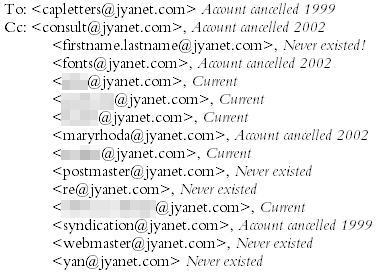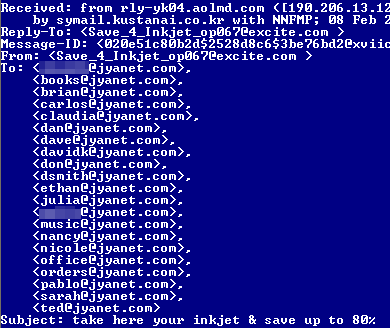
JY&A Consulting
https://jya.co
Spamming has always been regarded as bad by professional marketers. And now, it’s an even less worthwhile proposition
Jack Yan
Jack Yan is founder and CEO of Jack Yan & Associates and
president of JY&A Consulting.
ANY REAL MARKETER will tell you that spamming is about the worst thing you
can do. Not only are emails largely ineffective, with some research showing
that only urgent messages now get replied to, but unsolicited messages harm
an organization's goodwill drastically.
Linkshare lost my respect in the late 1990s after sending
two dozen spam, after I had unsubscribed from its service. Same thing: complaints
didn't work. Unsubs didn't work. Two written letters to Linkshare with a cease-and-desist
request didn't work. It was only till I started emailing Linkshare merchants,
potentially harming the company's bottom line, that someone there took notice.
While the Linkshare example isn't fair now, since the incidents
happened long enough in the internet world to be ancient history, and I would
hope the company has since learned a lesson, there are more recent ones. We've
seen them come from BET and Sony this year, probably as a consequence of someone
creating mischief and putting in an address with one of our domains, and it
took not one, but many, removal requests before they stopped.
But these are big organizations. What of smaller ones?
I'm sure we receive junk email from small-timers more often
than large companies, who know better. These are the ones that go around selling
everything from porn to the classic Nigerian (or 4-1-9) con-man scams. A lot
emanate from Red China and, increasingly, South America. Based on a study of
some of them, they come from emailing lists that allegedly (falsely) show opt-in
addresses, collected over the years. At the beginning of the World Wide Web,
some of us freely had mailto: links on our sites so people could readily contact
us. We even put our names into web directories. Those were the sources of both
spambots�programs that spammers use to collect addresses�and some manual collecting
by spammers (e.g. searching for Jacks in the directories yielded a collection
of email addresses from guys called Jack).
Now that it's been judged illegal by the Supreme Court in
New York state to falsely tell people you've opted in when you haven't (see
the NY Attorney-General's press release at <http://www.jyanet.com/0122pr0.htm>),
there's an even greater deterrent to spamming.
As the internet has grown, these databases have grown, too,
but internet marketers thinking of going the spam route: beware. The majority
of the addresses are invalid. Heck, last week I found one spam with a cc to
an address I had at college. It's embarrassing to tell you how long ago that
was. And email address-harvesting programs weren't always efficient at the beginning,
so there were truncated addresses that never existed. Here's part of the header
of one I received on November 18, selling healthcare, with addresses featuring
our domain name. I've made comments about each address in italics.

Of the 15 jyanet.com addresses the spammer has on its mailing list, only five
are current. If our company and this example are typical, then 67 per cent of
addresses on spam email lists aren't valid. Of the five who do get messages,
the spammer's goodwill has been flushed down the toilet because unless they're
really not choosy about the folks they associate with, or aren't particularly
discerning or intelligent (and probably don't have the money to waste on products
sold via spam) there's no way that they would become customers.
It’s getting worse and for the consumer, there's some
justice to all of this. Now, the people selling addresses are providing entirely
fictional ones. There are some con-men who are spammers, and now there are con-men
supplying the spammers—a case of the con-artists conning the con-artists.
We updated this article in early 2003 when we received an email selling inkjet
cartridges and laser-printer toner. It was caught in our filters, so we went
into DOS to get this:

In this example, only two of the addresses are valid and only three
have ever existed! The rest (18 of them) are completely fictional, so that means
the spammer has had a two-in-twenty-one strike rate—way worse than the
five-in-fifteen in the first example.
The market for email address databases must be pretty lucrative,
so why not outdo the competition and claim x times as many addresses?
It’s easy enough to make them up: get the usernames of one company’s
addresses and attach them to the domain names of others. Some spammers, especially
in Red China, have been doing this for a while when filling in the ‘From:’
fields in spams, by cobbling together a western-sounding Christian name with
a western-sounding surname.
Spammers don't know half the time if they have reached invalid
addresses, because they are so cowardly that they don't put a valid return address.
Often, they put someone else's address. Most of the time, they use aliases anyway.
I've had my address used twice this past week and the bounces come to guess
who? So the problem of invalid addresses never gets solved and spam loses even
more credibility.
Most of us hate spam and have done so since the beginning
of the internet. Now in 2002—and in 2003—it really looks an even less
likely marketing medium, reserved only for the amateur. Given most are coming
from countries playing with the �net for the first time, that's not too harsh
a judgement. •